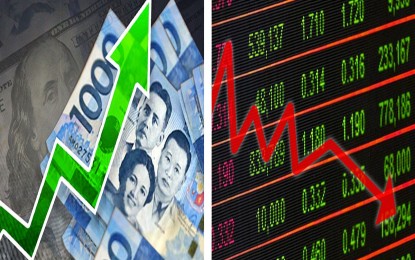
MANILA – The peso surged to its more than three-year high level against the US dollar Friday after Moody’s Investors Service affirmed its investment-grade rating on the country, but the main equities index contracted on worries on the rise of coronavirus disease 2019 (Covid-19) cases.
The local currency finished the week at 49.44 against the greenback from its 49.535 close Thursday.
It opened the day at 49.55 from 49.49 start in the previous session.
It traded between 49.57 and 49.41, resulting in an average of 49.493.
Volume totaled to USD687.8 million, lower than the USD768.49 million a day ago.
Rizal Commercial Banking Corporation (RCBC) chief economist Michael Ricafort attributed the peso’s strength to Moody’s Investors Service’s decision to affirm its Baa2 rating with a stable outlook on the Philippines.
“(This decision is) another sign of resilience on the country’s economic and credit fundamentals, including fiscal performance, as some other countries worldwide were downgraded due to Covid-19 pandemic/lockdowns,” he said in reply to e-mailed questions from Philippine News Agency.
Ricafort said local currency’s close Friday is among its strongest finish in more than three years, or since June 5, 2017 when it finished the trade at 49.40 to a greenback.
He said demand for safe-haven assets weakened recently due to improved global market risk appetite.
“There were pockets of healthy profit-taking lately after hefty gains amid positive developments on possible vaccine/cure vs. Covid-19 and improved US economic data recently such as retail sales, overshadowing the spike in new Covid-19 cases locally and in some US states/countries,” he added.
Ricafort also attributed the peso’s strength to the fund-raising activities of both the government, through the offering of retail treasury bonds (RTB) and the private sector, saying these “have entailed foreign buying/investments.”
He said the local currency has appreciated by PHP1.195, or 2.4 percent, since the start of the year.
He forecasts the peso to trade between 49.30-49.60 to a greenback next week.
Meanwhile, the Philippine Stock Exchange index (PSEi) declined a day after posting a recovery.
It finished the trade at 6,088.75 points, down by 0.96 percent or 58.91 points.
All Shares contracted by 0.78 percent, or 28.20 points, to 3,579.60 points.
Only the Industrial counter finished the week with gains after rising by 0.02 percent.
Property posted the highest drop with 3.51 percent, and was followed by Mining and Oil, 1.34 percent; Holding Firms, 0.34 percent; Services, 0.11 percent; and Financials, 0.10 percent.
Volume reached 1.84 billion shares amounting to PHP4.12 billion.
Losers surpassed gainers at 123 to 69, while 44 shares were unchanged.
Ricafort said the main index’s end Friday is its lowest in more than two weeks partly on account of “the continued increase in new local Covid-19 cases that could have some adverse impact on the pace of economic recovery amid some risk of possible tighter quarantine standards especially on Metro Manila.”
“However, the PSEi is still among four-month highs (since March 12, 2020),” he said.
Ricafort said the main equities index slipped for the second consecutive week by 108.63 points or 1.7 percent and has dipped by 1,726.51 points or 22.1 percent since the start of the year. It finished 2019 at 7,815.26 points.
“From the low of 4,039.15 posted on March 19, 2020, the PSEi still gained by +50.7%. Thus, the recent profit-taking/downward correction may not be as surprising,” he added.
Factors for next week’s trading include the ongoing RTB sale, which is scheduled to end on August 7, 2020, and the bond sale by some major companies.
However, Ricafort said these factors “could potentially sap/attract some of the excess liquidity in the financial system and compete with/reduce demand for other existing securities/issues (that could have led to some healthy profit-taking after hefty gains, as seen recently).” (PNA)
